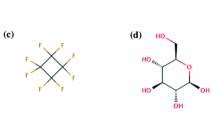Abstract
Dissociation of ascorbic acid in water has been studied by using a cluster model. It was examined by density functional theory (DFT) with the В3LYP, M06, and wB97XD functionals and a 6–311++G(d,p) basis set. The thermodynamic and kinetic characteristics of proton transfer from ascorbic acid molecule to water clusters were calculated as well as the equilibrium constants (pK a ) for the related processes. The used functionals in the DFT method together with continuum solvent models provided results close to the experimental data for the dissociation constant of ascorbic acid in aqueous solution.

Route of ascorbic acid dissociation in aqueous solution





Similar content being viewed by others
References
Davey MW, Montagu MV, Inzé D, Sanmartin M, Kanellis A, Smirnoff N, Benzie IJ, Strain JJ, Favell D, Fletcher J (2000) Plant L-ascorbic acid: chemistry, function, metabolism, bioavailability and effects of processing. J Sci Food Agric 80:825–860
Garcia-Diaz DF, Campion J, Milagro FI, Paternain L, Solomon A, Martinez JA (2009) Ascorbic acid oral treatment modifies lipolytic response and behavioural activity but not glucocorticoid metabolism in cafeteria diet-fed rats. Acta Physiol 195:449–457
Cameron E (1976) Biological function of ascorbic acid and the pathogenesis of scurvy: A working hypothesis. Med Hypotheses 2:154–163
Austria R, Semenzato A, Bettero A (1997) Stability of vitamin C derivatives in solution and topical formulations. J Pharmaceut Biomed 15:795–801
Piao H, Kamiya N, Cui F, Goto M (2011) Preparation of a solid-in-oil nanosuspension containing l-ascorbic acid as a novel long-term stable topical formulation. Int J Pharm 420:156–160
Taqui Khan MM, Martell AE (1967) Metal ion and metal chelate catalyzed oxidation of ascorbic acid by molecular oxygen. I. Cupric and ferric ion catalyzed oxidation. J Am Chem Soc 89:4176–4185
Abe Y, Okada S, Nakao R, Horii T, Inoue H, Taniguchi S, Yamabe SJ (1992) A molecular orbital study on the reactivity of L-ascorbic acid towards OH radical. J Chem Soc Perk Trans 2:2221–2232
Meng XG, Kou XM, Xie JQ, Du J, Zeng XC (2004) Microcalorimetric investigation on the kinetics of the oxidation of ascorbic acid with hydrogen peroxide. Chin J Chem 22:515–520
Lee C, Sosa C, Novoa JJ (1995) Evidence of the existence of dissociated water molecules in water clusters. J Chem Phys 103:4360–4362
Jensen JO, Samuels AC, Krishnan PN, Burke LA (1997) Ion pair formation in water clusters: a theoretical study. Chem Phys Lett 276:145–151
Cárdenas R, Lagúnez-Otero J, Flores-Rivero A (1998) Ab initio study of the reaction mechanism of water dissociation into the ionic species OH− and H3O+. Int J Quantum Chem 68:253–259
Bernal-Uruchurtu MI, Ortega-Blake I (1999) On the molecular basis of water hydrolysis. A detailed ab initio study. J Phys Chem A 103:884–892
Re S, Osamura Y, Morokuma K (1999) Coexistence of neutral and ion-pair clusters of hydrated sulfuric acid H2SO4(H2O)n (n = 1 − 5) − A molecular orbital study. J Phys Chem A 103:3535–3547
Temelso B, Morrell TE, Shields RM, Allodi MA, Wood EK, Kirschner KN, Castonguay TC, Archer KA, Shields GC (2012) Quantum mechanical study of sulfuric acid hydration: atmospheric implications. J Phys Chem A 116:2209–2224
Smith A, Vincent MA, Hillier IH (1999) Mechanism of acid dissociation in water clusters: Electronic structure studies of (H2O)nHX (n = 4, 7; X = OH, F, HS, HSO3, OOSO2H, OOH·SO2). J Phys Chem A 103:1132–1139
Tachikawa M (2002) Isotope effect and cluster size dependence for water and hydrated hydrogen halide clusters: multi-component molecular orbital approach. Mol Phys 100:881–901
Planas M, Lee C, Novoa JJ (1996) Kinetics of the proton transfer in X···(H2O)4 clusters (X = H2O, NH3, H2S, and HCl): Evidence of a concerted mechanism. J Phys Chem 100:16495–16501
Lee C, Sosa C, Planas M, Novoa JJ (1996) A theoretical study of the ionic dissociation of HF, HCl, and H2S in water clusters. J Chem Phys 104:7081–7085
Tachikawa M (2004) A density functional study on hydrated clusters of orthoboric acid, B(OH)3(H2O) n (n = 1–5). J Mol Struct Theochem 710:139–150
Demianenko E, Ilchenko M, Grebenyuk A, Lobanov V (2011) A theoretical study on orthosilicic acid dissociation in water clusters. Chem Phys Lett 515:274–277
Boese AD, Forbert H, Masia M, Tekin A, Marx D, Jansen G (2011) Constructing simple yet accurate potentials for describing the solvation of HCl/water clusters in bulk helium and nanodroplets. Phys Chem Chem Phys 13:14550–14564
Zwier TS (2009) Squeezing the Water Out of HCl(aq). Science 324:1522–1523
Walewski L, Forbert H, Marx D (2013) Revealing the Subtle Interplay of Thermal and Quantum Fluctuation Effects on Contact Ion Pairing in Microsolvated HCl. Chem Phys Chem 14:817–826
Carlson GL, Cable H, Pedersen LG (1976) An ab initio study of ascorbic acid. Chem Phys Lett 38:75–78
Allen RN, Shukla MK, Reed D, Leszczynski J (2006) Ab initio study of the structural properties of ascorbic acid (vitamin C). Int J Quantum Chem 106:2934–2943
Yadav RA, Rani P, Kumar M, Singh R, Singh P, Singh NP (2011) Experimental IR and Raman spectra and quantum chemical studies of molecular structures, conformers and vibrational characteristics of l-ascorbic acid and its anion and cation. Spectrochim Acta A 84:6–21
Al-Laham MA, Petersson GA, Haake P (1991) Ab initio study of ascorbic acid conformations. J Comput Chem 12:113–118
Mora MA, Melendez FJ (1998) A Conformational ab initio study of ascorbic acid. J Mol Struct Theochem 454:175–185
Bailey DM, George WO, Gutowski M (2009) Theoretical studies of l-ascorbic acid (vitamin C) and selected oxidised, anionic and free-radical forms. J Mol Struct Theochem 910:61–68
Singh P, Singh NP, Yadav RA (2010) Study of the optimized molecular structures and vibrational characteristics of neutral l-ascorbic acid and its anion and cation using density functional theory. J Chem Pharm Res 2:656–681
Dimitrova Y (2006) Theoretical study of the changes in the vibrational characteristics arising from the hydrogen bonding between Vitamin C (l-ascorbic acid) and H2O. Spectrochim Acta A 63:427–437
Kumler WD, Daniels TC (1935) Titration curves and dissociation constants of l-ascorbic acid (Vitamin C) and diethyl dihydroxymaleate. J Am Chem Soc 57:1929–1930
Taqui Khan MM, Martell AE (1969) Kinetics of metal ion and metal chelate catalyzed oxidation of ascorbic acid. IV. Uranyl ion catalyzed oxidation. J Am Chem Soc 91:4668–4672
Jaiswal PV, Ijeri VS, Srivastava AK (2005) Effect of surfactants on the dissociation constants of ascorbic and maleic acids. Colloids Surfaces B 46:45–51
Kreye WC, Seybold PG (2009) Correlations between quantum chemical indices and the pKas of a diverse set of organic phenols. Int J Quantum Chem 109:3679–3684
Juhasz JR, Pisterzi LF, Gasparro DM, Almeida DRP, Csizmadia IG (2003) The effects of conformation on the acidity of ascorbic acid: a density functional study. J Mol Struct Theochem 666–667:401–407
Montgomery JA Jr, Peralta PE, Ogliaro F, Bearpark M, Heyd JJ, Brothers E, Kudin KN, Staroverov VN, Kobayashi R, Normand J, Raghavachari K, Rendell A, Burant JC, Iyengar SS, Tomasi J, Cossi M, Rega N, Millam NJ, Klene M, Knox JE, Cross JB, Bakken V, Adamo C, Jaramillo J, Gomperts R, Stratmann RE, Yazyev O, Austin AJ, Cammi R, Pomelli C, Ochterski JW, Martin RL, Morokuma K, Zakrzewski VG, Voth GA, Salvador P, Dannenberg JJ, Dapprich S, Daniels AD, Farkas Ö, Ortiz JV, Cioslowski J, Fox DJ (2009) Gaussian 09. Gaussian Inc, Wallingford
Becke AD (1993) Density functional thermochemistry. III. The role of exact exchange. J Chem Phys 98:5648–5653
Lee C, Yang W, Parr RG (1988) Development of the Colle-Salvetti correlation-energy formula into a functional of the electron density. Phys Rev B 37:785–789
Zhao Y, Truhlar DG (2008) The M06 suite of density functionals for main group thermochemistry, thermochemical kinetics, noncovalent interactions, excited states, and transition elements: two new functionals and systematic testing of four M06-class functionals and 12 other functionals. Theor Chem Account 120:215–241
Valero R, Costa R, Moreira IPR, Truhlar DG, Illas F (2008) Performance of the M06 family of exchange-correlation functionals for predicting magnetic coupling in organic and inorganic molecules. J Chem Phys 128:114103
Chai JD, Head-Gordon M (2008) Long-range corrected hybrid density functionals with damped atom–atom dispersion corrections. Phys Chem Chem Phys 10:6615–6620
Petković M (2012) O–H stretch in phenol and its hydrogen-bonded complexes: band position and relaxation pathways. J Phys Chem A 116:364–371
Fortunelli A, Tomasi J (1994) The implementation of density functional theory within the polarizable continuum model for solvation. Chem Phys Lett 231:34–39
Takano Y, Houk KN (2005) Benchmarking the conductor-like polarizable continuum model (CPCM) for aqueous solvation free energies of neutral and ionic organic molecules. J Chem Theory Comput 1:70–77
Jang YH, Sowers LC, Ģağin T, Goddard WA III (2001) First principles calculation of pKa values for 5-substituted uracils. J Phys Chem A 105:274–280
Jensen F (2007) Introduction to computational chemistry. John Wiley & Sons, Odense
Murrell JN, Laidler KJ (1968) Symmetries of activated complexes. Trans Faraday Soc 64:371–377
Boys SF, Bernardi F (1970) The calculation of small molecular interactions by the differences of separate total energies. Some procedures with reduced errors. Mol Phys 19:553–566
Plumley JA, Dannenberg JJ (2011) A comparison of the behavior of functional/basis set combinations for hydrogen-bonding in the water dimer with emphasis on basis set superposition error. J Comput Chem 32:1519–1527
Berger S (1977) Vitamin C—A 13C magnetic resonance study. Tetrahedron 33:1587–1589
Costanzo F, Sulpiz M, Vandevondele J, Della Valle RG, Sprik M (2007) Ab initio molecular dynamics study of ascorbic acid in aqueous solution. Mol Phys 105:17–23
Shestakov AF (2003) Quantum-chemical verification of the Polanyi–Semenov generalized relationship. Dokl Phys Chem 393:339–342
Tsendra O, Lobanov V, Grebenyuk A (2008) Structure and Properties of Hydrated Complexes of Methylphosphonic Acids. J Mol Struct THEOCHEM 864:14–19
Grimme S, Antony J, Ehrlich S, Krieg H (2010) A consistent and accurate ab initio parametrization of density functional dispersion correction (DFT-D) for the 94 elements H-Pu. J Chem Phys 132:154104
Acknowledgment
Authors are grateful to Professor Jerzy Leszczynski (Department of Chemistry and Biochemistry, Jackson State University, MS, USA) for providing access to computational resources.
Author information
Authors and Affiliations
Corresponding author
Rights and permissions
About this article
Cite this article
Demianenko, E., Ilchenko, M., Grebenyuk, A. et al. A theoretical study on ascorbic acid dissociation in water clusters. J Mol Model 20, 2128 (2014). https://doi.org/10.1007/s00894-014-2128-5
Received:
Accepted:
Published:
DOI: https://doi.org/10.1007/s00894-014-2128-5




